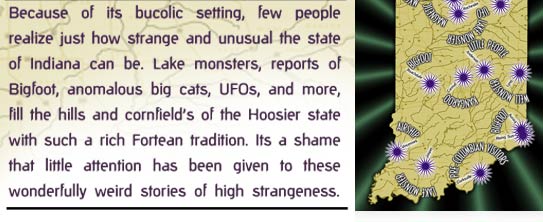|
|
|
|
|
|
 |
 |
| |

|
|
Located in the southern Great Lakes region of the United States, Indiana was once covered with a vast, shallow sea some 300 million years ago during the Paleozoic era. This sea was home to corals and other sea creatures that created the huge deposits of limestone reefs so valued today by builders worldwide. During the last Ice Age, Indiana was almost completely covered with the Wisconsin glacial sheet that smoothed out the landscape resulting in the rich, flat farmlands we see today. The southern half of Indiana, however, escaped the bulldozers of ice, leaving a hilly, forested terrain. No one really knows when humans first encountered the lands that would later be known as Indiana, since no written history exists of this ancient period. Artifacts and physical evidence indicates that the first inhabitants of Indiana were an aboriginal people who relied on hunting and gathering to survive. These aborigines, commonly called "the Mound Builders," lived throughout the state, usually along rivers and streams. These prehistoric people built a vast array of earthworks, primarily mounds, cones and ditches. Some can still be seen today in Mounds State Park near the city of Anderson, and the Angel Mounds state historic site in southern Indiana. The Mound Builders are commonly divided into four cultures: The Shell Culture (400-500 A.D.), The Adena Culture (700-800 A.D.), The Hopewell Culture (800-900 A.D.) and the Middle-Mississippi Culture (1000-1200 A.D.). The societies that built these impressive structures lived throughout Indiana, Ohio, Illinois, Missouri and Kansas. Oral traditions of Native Americans, who populated the area after the Mound Builders, state that these areas were part of a sophisticated civilization whose religious influence reached down into South America. Reportedly, a vast trail leading from South and Central America existed to enable pilgrims to journey to their spiritual Mecca located within the Mound Builders societies. In fact, recent evidence has shown that the earthworks had been built not as burial sites, as historians believed, but as religious sites aligned with various celestial bodies and events. After the collapse of the Mound Builders society, much of Indiana became uninhabited, and was used by several Native American tribes as hunting areas. Permanent villages were not established in Indiana during this time because of legends of hairy, cannibalistic "wildmen" who allegedly lived in caves along streams and rivers. However, around the year 1170 A.D., Southern Indiana may have been the final home to a group of Welsh explorers who died at the hands of hostile Native Americans.
|
|
|
THE
LEGEND OF PRINCE MADOC
|
|
|
|
|
|
|